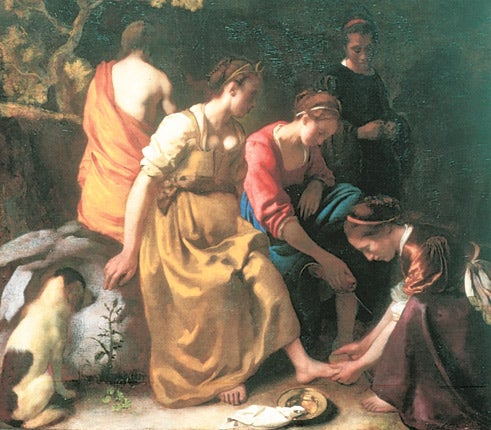The Young Vermeer, National Gallery of Scotland, Edinburgh

This tiny show of just three paintings, hung in a small, chapel-like rotunda in Edinburgh's National Gallery, is of great importance. Vermeer of Delft painted little. He came to fame late. Unlike Rembrandt and Gerrit Dou, he was not celebrated during his lifetime, and it was not until the middle of the 19th century that his works were rescued from oblivion, and began to be valued and evaluated properly. He produced about 60 works during his lifetime, of which just 36 survive. Given that he had a working life of approximately 20 years, this amounts to about three paintings a year.
So we have before our eyes 10 per cent of Vermeer's surviving output, shown all together for the first time, and all produced over a span of about three years, from 1653-6. They are very different in certain respects from the works of the mature Vermeer, but in other ways we see that other painter emerging into being in these canvases of his relative youth. Their single most striking feature is their size. How tub-thumpingly large they for Vermeers! We had thought that he was always intimately small. Not so.
In these works, Vermeer is striving to become known as a history painter in the making. The first of the three, Diana and Her Nymphs, is a version of a celebrated mythological scene, but it lacks the explosive narrative drive of other famous paintings that circle about this theme. It is quietly pitched, almost meditative. We see a small group of woman. One is kneeling, washing Diana's feet. Would we know that this was a scene from classical mythology? Barely at all. There is already an air of self-absorption in the way that these women's faces have been painted, which would be one of the defining characteristics of the mature painter. We also see the way in which he luxuriates in the use of colour on fabric, and how he plays with the light.
The second, Christ in the House of Martha and Mary, painted a little later, is the re-imagining of an episode from the New Testament. Martha brings in the bread, a round loaf. Christ is seated, gesturing towards Mary. Mary is listening, rapt, crouched beside the table. Her enshadowed face, dark against the bright whiteness of the table cloth, is in profile. The third painting, which 19th-century critics decided to call The Procuress, makes a mighty leap in the direction of maturity. This is a genre painting, a scene of ordinary life. We are inside a brothel. We could call this a rather sinister vicious scene if we chose to do so. A young woman is being pawed over by a man with a coin in his hand, while another man looks on, leeringly. An old woman, the procuress, has a fiercely intent, raptor-like stare. And yet this painting, tonally, feels so tender. The young woman wears a lovely yellow blouson. The painting is almost dominated by a rug painted so carefully, so colourfully, so rapturously, and the young seductor's red coat with its piping so beguiles us too, that we rather feel that Vermeer gave no more than a second's thought to whether the scene was morally dubious. Ah, with freshly mixed paint, applied in such broad strokes, one can do so much! Yes, that's probably what he thought.
To 13 March (0131 624 6200 )
Subscribe to Independent Premium to bookmark this article
Want to bookmark your favourite articles and stories to read or reference later? Start your Independent Premium subscription today.

Join our commenting forum
Join thought-provoking conversations, follow other Independent readers and see their replies